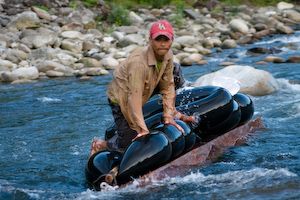We return from Ke village well after dark. Where we're staying is closest to the village of Nuoc Sot, really nothing more than an intersection in the road, an army barracks, and a hot springs resort, which seems a bit overbuilt, considering the size of the local population. Soon we discover that we're only about 5km from the border crossing between Vietnam and Laos at Cau Treo, so the quiet road transecting this piece of land, primarily used by water buffaloes, is occasionally punctuated by a bus on its way to or from Laos, full of people, baggage and chicken cages strapped on top, careening around the switchbacks.
In the early morning, the forest looks like impenetrable jungle to my American eye, the river meandering along the border of the land here looks pristine. At dawn we see a man walking along the river with a fishing net. Every day before sunset we have seen water buffaloes slowly ambling down the shallow riverbeds with a log in tow. How picturesque, I think.
Where we are staying is a farm school called HEPA, built on land donated to SPERI from the Vietnam government. There is no official land ownership in Vietnam - land usage rights are bought and sold instead. The government officials had suggested to Lanh, the head of SPERI, that she might want someplace better than this land, with better soil, easier to get to, but this is what she decided upon.
It isn't as untouched as it appears, it turns out. This pristine wilderness is a kind of Smuggler's Junction - a teeming highway of illegal trade in wild animals and illegally harvested timber – between Vietnam and Laos, and out to Malaysia. The farm school full of sweet young aspiring farmers is placed squarely in the intersection of a major thoroughfare for illegal hunting and logging.Later in the day we walk along the road to the conflux of the two rivers, passing by the neighbor's house. Two men ride up on motor bikes, long zippered gun cases under their arms. Later on we see these same neighbors and friends riding logs down the river – the logs tied to inner tubes to they float easily over the small rapids. Followed by buffaloes pulling logs. Today was a good day for harvesting timber, it seems. The logs go slowly down the river in one fashion or as long as we are watching, till it gets dark and we climb the hill back up to HEPA for dinner. Headed eventually for Malaysia, we're told.
The Vietnamese government is trying to stop illegal logging and hunting of endangered animals. Their effort in this direction makes the papers daily. SPERI has taken on settling this piece of land in large part to get the smugglers to have to either stop or slow down their activity. The dirt road that passes the school is hardly used. Instead the loggers are using the river to bypass the school grounds, where they know they'll get stopped by the farm students.
The ban on illegal logging and hunting is a great idea by anyone's standards. But what are the options for a family to make money living in this terrain, marginally arable, and isolated from other income sources? For some, perhaps this is the trade they conduct to be able to keep their families from moving to town.
But there are definitely other beneficiaries of this trade. Later the next day, driving out from our corner of Ha Tinh Province to the town of Pho Chau, there's a slowdown of traffic going over a narrow bridge as we enter the town.The first car to clear the road is a cream colored Lexus, very new, very shiny, the driver wearing Ray-Bans, two ivory tusks set in gold on the dashboard.



